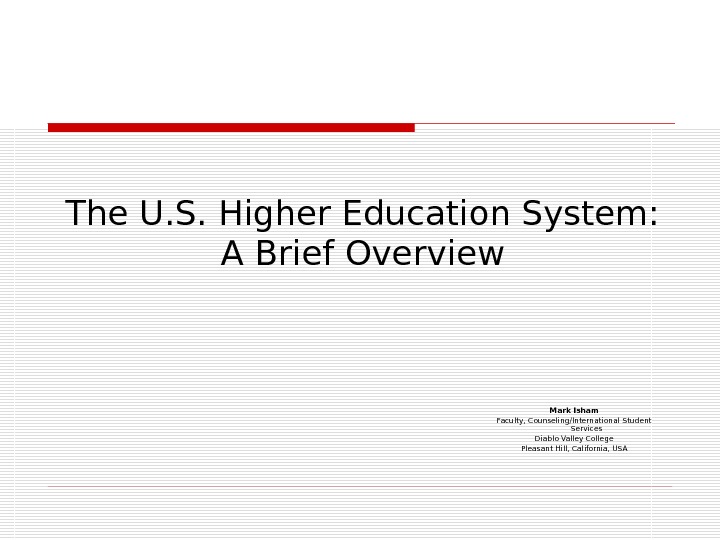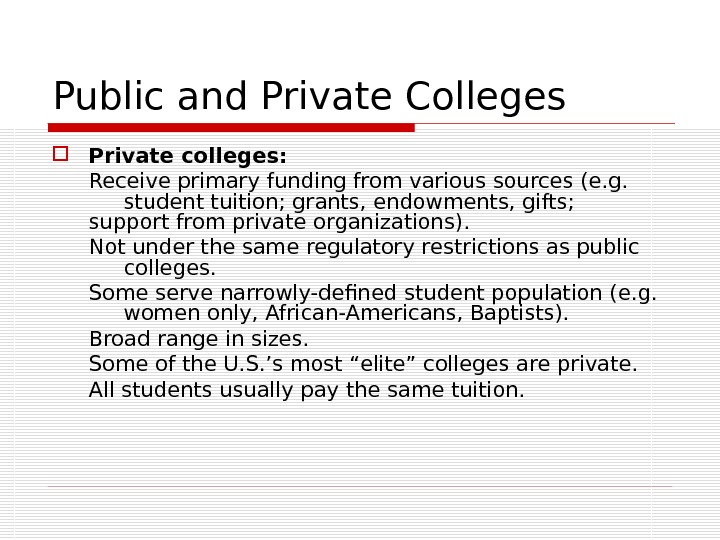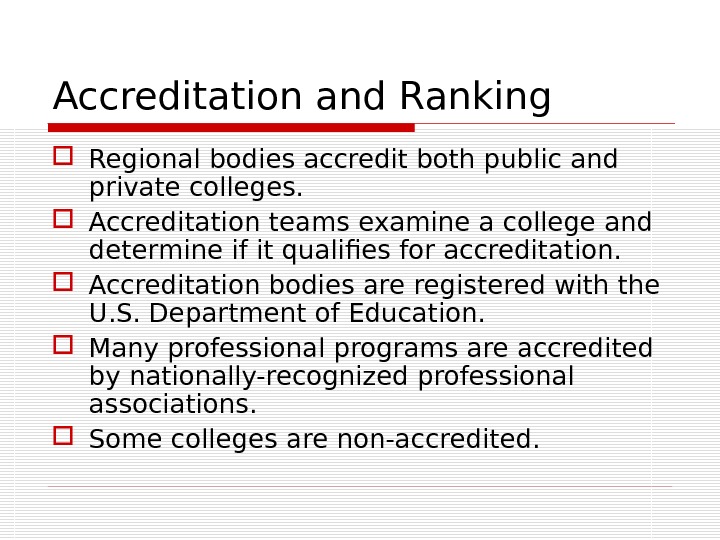The U. S. Higher Education System: A Brief










- Размер: 138.5 Кб
- Количество слайдов: 9
Описание презентации The U. S. Higher Education System: A Brief по слайдам
 The U. S. Higher Education System: A Brief Overview Mark Isham Faculty, Counseling/International Student Services Diablo Valley College Pleasant Hill, California, US
The U. S. Higher Education System: A Brief Overview Mark Isham Faculty, Counseling/International Student Services Diablo Valley College Pleasant Hill, California, US
 Overview of U. S. Higher Education More than 3, 000 colleges and universities in the U. S. Enrollments can range from a few hundred or less, to 50, 000 or more. State and local governments, boards of trustees, and/or private enterprises regulate; little direct regulation by the federal government.
Overview of U. S. Higher Education More than 3, 000 colleges and universities in the U. S. Enrollments can range from a few hundred or less, to 50, 000 or more. State and local governments, boards of trustees, and/or private enterprises regulate; little direct regulation by the federal government.
 Public and Private Colleges* Public Colleges: Primarily funded by state and local governments. Must maintain certain state-wide standards. Must serve the needs of the taxpayers of that state. Out-of-state students (including international students) pay higher tuition because they and their families are not and have not been taxpayers of that state. *”College” is used generically to refer to any post-secondary institution.
Public and Private Colleges* Public Colleges: Primarily funded by state and local governments. Must maintain certain state-wide standards. Must serve the needs of the taxpayers of that state. Out-of-state students (including international students) pay higher tuition because they and their families are not and have not been taxpayers of that state. *”College” is used generically to refer to any post-secondary institution.
 Public and Private Colleges Private colleges: Receive primary funding from various sources (e. g. student tuition; grants, endowments, gifts; support from private organizations). Not under the same regulatory restrictions as public colleges. Some serve narrowly-defined student population (e. g. women only, African-Americans, Baptists). Broad range in sizes. Some of the U. S. ’s most “elite” colleges are private. All students usually pay the same tuition.
Public and Private Colleges Private colleges: Receive primary funding from various sources (e. g. student tuition; grants, endowments, gifts; support from private organizations). Not under the same regulatory restrictions as public colleges. Some serve narrowly-defined student population (e. g. women only, African-Americans, Baptists). Broad range in sizes. Some of the U. S. ’s most “elite” colleges are private. All students usually pay the same tuition.
 College Calendars Most colleges in the U. S. follow the semester system: Average 16 weeks long. Fall and Spring semesters. Maybe Summer semester, 8 -12 weeks long. Some colleges in the U. S. follow the quarter system: Academic year is divided into four quarters of about 10 weeks each. May be some variation in the summer quarter. A few colleges follow a trimester system, with three terms per year, about 12 weeks per term. Academic year begins in the Fall (August or September).
College Calendars Most colleges in the U. S. follow the semester system: Average 16 weeks long. Fall and Spring semesters. Maybe Summer semester, 8 -12 weeks long. Some colleges in the U. S. follow the quarter system: Academic year is divided into four quarters of about 10 weeks each. May be some variation in the summer quarter. A few colleges follow a trimester system, with three terms per year, about 12 weeks per term. Academic year begins in the Fall (August or September).
 Accreditation and Ranking Regional bodies accredit both public and private colleges. Accreditation teams examine a college and determine if it qualifies for accreditation. Accreditation bodies are registered with the U. S. Department of Education. Many professional programs are accredited by nationally-recognized professional associations. Some colleges are non-accredited.
Accreditation and Ranking Regional bodies accredit both public and private colleges. Accreditation teams examine a college and determine if it qualifies for accreditation. Accreditation bodies are registered with the U. S. Department of Education. Many professional programs are accredited by nationally-recognized professional associations. Some colleges are non-accredited.
 Accreditation & Ranking (continued) Some publications (e. g. U. S. News and World Report) have a college ranking system. Most students choose college based on geographic location, major/program offerings, family/friends, scholarship/financial aid packages, and even sports teams.
Accreditation & Ranking (continued) Some publications (e. g. U. S. News and World Report) have a college ranking system. Most students choose college based on geographic location, major/program offerings, family/friends, scholarship/financial aid packages, and even sports teams.
 Common Classifications of U. S. Colleges Liberal Arts – focus on Humanities and well-rounded citizenship. Research – focus primarily on math, science, engineering, and social sciences. Land Grant – founded by one of two U. S. government initiatives in the latter part of the 19 th century to make college education accessible in rural locations. Focused on agriculture and technology originally, now usually very comprehensive in scope and research-based.
Common Classifications of U. S. Colleges Liberal Arts – focus on Humanities and well-rounded citizenship. Research – focus primarily on math, science, engineering, and social sciences. Land Grant – founded by one of two U. S. government initiatives in the latter part of the 19 th century to make college education accessible in rural locations. Focused on agriculture and technology originally, now usually very comprehensive in scope and research-based.
 Basic Distinctions in U. S. Post-secondary Institutions Two-year: Junior Colleges Community Colleges Four-year: Liberal Arts College Comprehensive University Bachelor’s only Graduate degrees Research Institution
Basic Distinctions in U. S. Post-secondary Institutions Two-year: Junior Colleges Community Colleges Four-year: Liberal Arts College Comprehensive University Bachelor’s only Graduate degrees Research Institution

